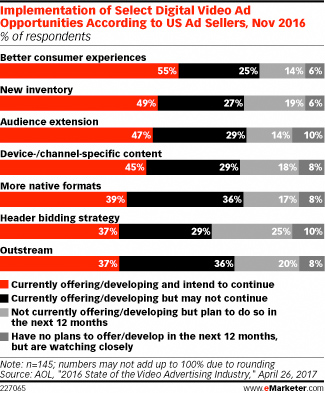Understanding Out-Stream Video Advertising
July 20, 2017
![]() Out-stream video advertising has emerged as an important revenue source for social media companies and publishers with limited or no video content. But while out-stream seems poised for continued growth, certain obstacles could halt its progress—including concerns over potential ad fraud.
Out-stream video advertising has emerged as an important revenue source for social media companies and publishers with limited or no video content. But while out-stream seems poised for continued growth, certain obstacles could halt its progress—including concerns over potential ad fraud.
Out-stream ads deliver a user experience that some consider less intrusive than various types of in-stream video units. “eMarketer defines out-stream video as a form of digital advertising in which video units are served in nonvideo environments, including text articles, social media feeds and video games. The term ‘out-stream’ is meant to distinguish these ads from formats that run within a video stream, such as pre-roll, mid-roll and post-roll,” said Paul Verna, principal analyst at eMarketer and author of the new report “Out-Stream Video Advertising: Viewing Between the Lines.”
Hear more from Verna and eMarketer principal analyst Lauren Fisher on out-stream video ads in the latest episode of “Behind the Numbers.”
Although out-stream seems poised for continued growth, there are certainly obstacles that could halt its progress. These include concerns over potential ad fraud, a relative lack of measurement data to corroborate its value, a perceived disconnect between text-based content and video-based ads, and the possibility that out-stream ads could be detrimental to media brands in the long term.
 “Out-stream video is very susceptible to bots and fraudulent traffic,” said Shailin Dhar, founder and director of research at ad tech firm Method Media Intelligence. “With out-stream, you look at the page and there is no extra check for [the publisher] to have video ads vs. normal banners. The same basic WordPress site can have video advertising revenues coming from out-stream ads,” he said.
“Out-stream video is very susceptible to bots and fraudulent traffic,” said Shailin Dhar, founder and director of research at ad tech firm Method Media Intelligence. “With out-stream, you look at the page and there is no extra check for [the publisher] to have video ads vs. normal banners. The same basic WordPress site can have video advertising revenues coming from out-stream ads,” he said.
Dhar’s contention is that with out-stream video becoming more commonplace and ubiquitous, it is much easier for sellers to falsely claim they are selling out-stream units in the exchanges to trick buyers into paying higher CPMs.
Along with the disconnect between text-based content and video-based ads that Dhar alluded to, there’s potential for confusion in the advertising community as to whether video ads are out-stream or in-stream. This comes from varying definitions and perceptions of out-stream, as well as the fact that the format is still new.
Ad exchanges and tech firms are working to make the delineations clearer, but at least in the short term, the industry needs to grapple with the possibility that some buyers will get something other than what they thought they were paying for.
There is not yet a solid body of research on the types of metrics that allow buyers and sellers to transact out-stream video ads on a clear, level surface.
One recent study that compared out-stream to other formats did not paint a particularly positive picture for out-stream. In AOL’s “2016 State of the Video Advertising Industry” report, both US ad buyers and sellers surveyed in November 2016 were less likely to cite out-stream as one of their top 2 digital video revenue drivers for the next 12 months than any other format.
The study also noted that out-stream ranked lowest among digital video ad formats available. Only 37% of the ad sellers said they were offering or developing out-stream ads and intended to continue, and a nearly equal number said they were offering them but weren’t likely to continue doing so. Other items on the list scored better than out-stream across the board.































